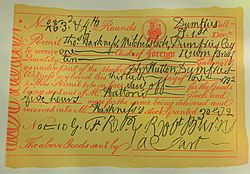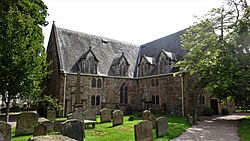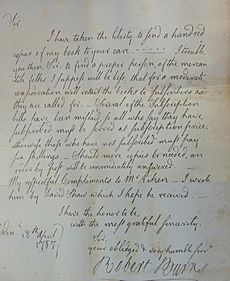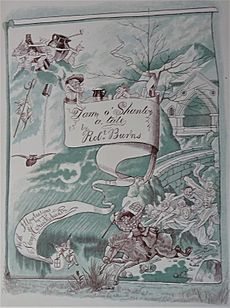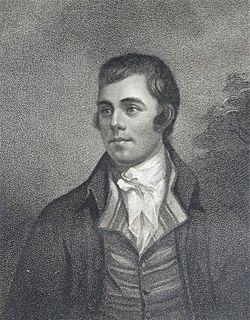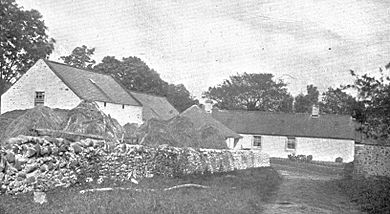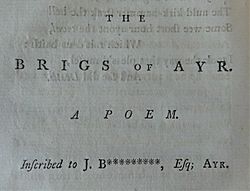John Ballantine (banker) facts for kids
Quick facts for kids
John Ballantine
|
|
|---|---|

The Auld and New Brigs of Ayr
|
|
| Born | 24 July 1743 Ayr
|
| Died | 15 July 1812 Scotland
|
| Occupation | Merchant and Banker |
John Ballantine (1743–1812) was a Scottish businessman and banker. He was a very close friend and supporter of the famous poet Robert Burns. John even helped Burns choose poems for his first book, the Kilmarnock Edition. He also gave his thoughts on Burns's other poems.
John Ballantine's Life
John Ballantine was born in Ayr, Scotland. His father, William Ballantine, was a local official called a baillie. John grew up to be a successful merchant and banker. In 1787, he became the Provost of Ayr, which is like being the mayor. During his time as Provost, he helped start the Ayr Academy, a school. He also played a big part in building a new bridge over the River Ayr. John died at 68 and is buried in Ayr. He never married. His home, Castlehill House, is now gone, but the area is still called Castlehill.
Friendship with Robert Burns
Burns often sent his poems to John Ballantine for feedback. Their letters became less frequent later, possibly because Burns was unwell.
In 1791, Robert Burns thanked Ballantine for helping him become famous. He said Ballantine helped him get "up to the Court of the Gentiles, in the Temple of Fame." This was a reference to the ancient Temple in Jerusalem, where only the outer part was open to non-Jewish people.
Burns dedicated his poem "The Brigs of Ayr" to Ballantine. This poem was not ready for the 1786 Kilmarnock Edition. When a second edition seemed unlikely, Burns wrote that he was sad he couldn't show his thanks to Ballantine. He said he would never forget Ballantine's kindness and support.
It is thought that either Ballantine or Robert Aiken spoke to Dr. Patrick Douglas about Burns. Dr. Douglas had property in Jamaica, and Burns had thought about moving there for work.
John Wilson, the printer of Burns's first book, wanted money upfront for a second edition. Gilbert Burns, Robert's brother, said Ballantine offered to lend Burns the money. However, Ballantine also suggested that Burns look for a publisher in Edinburgh. Burns did not take the loan. Ballantine had also given advice on which poems to include in the Kilmarnock Edition.
Ballantine helped Burns a lot with publishing his books. He received many subscription forms for the First Edinburgh Edition. On February 24, 1787, he was told the book would be out soon. It was finally printed on April 18, 1787. Ballantine received one hundred copies of the new book on its first day.
Ballantine introduced Robert Burns to James Dalrymple of Orangefield. This introduction was very important for Burns to enter Edinburgh society. James Dalrymple was related to important people like James Cunningham, Earl of Glencairn.
Ballantine also seemed to be one of the people who helped Burns join the Excise service. This was a job collecting taxes on goods.
In January 1801, Ballantine attended the first Burns Supper. He was there with Robert Aiken and nine other friends of Burns. They ate traditional Scottish food like sheep's head and haggis.
Letters from Robert Burns
In 1783, Burns wrote to Ballantine calling Robert Aiken his "first poetic patron."
Around October 8, 1786, Burns wrote that he had settled all costs with John Wilson, his printer. He said that printing a thousand copies would cost about £27 for paper and £15-£16 for printing. Wilson offered to print if Burns paid for the paper, but Burns said he couldn't afford it. He wrote, "so farewell hopes of a second edition till I grow richer!"
Burns also sent Ballantine his poem "A Winter Night." He asked for Ballantine's opinion on it. By November 28, 1786, Burns planned to visit Ayr. He hoped to get advice from Ballantine and Robert Aiken about his second edition.
In 1786, Burns wrote to Ballantine about "The Brigs of Ayr." He said he had dedicated the poem to him. He explained it was not to gain a rich supporter, but from "heart-felt Gratitude."
On December 13, 1786, Ballantine received a letter saying Burns was close to an agreement with William Creech to print his book. Burns also sent a copy of "Death and Dr Hornbook" to Ballantine. He thought this poem was "too trifling and prolix to publish" and only sent it for Ballantine's amusement.
On December 13, 1786, Burns wrote to Ballantine about his new friends in Edinburgh. He mentioned important people like the Duchess of Gordon. He also said he had "warm friends among the Literati," meaning learned people. Burns also shared that an unknown person had given him ten guineas, which he later found out was from Patrick Miller. Burns felt a bit overwhelmed by all the attention.
In the same letter, Burns told Ballantine that his friends had written about him in a newspaper called 'The Lounger'. He even enclosed a copy.
Burns described his Edinburgh landlady to Ballantine. He said she was a "staid, sober, piously disposed" widow. She was very upset about some noisy "Daughters of Belial" living on the floor above. Because the floors were thin, they could hear everything their neighbors did. This kept his landlady awake all night.
On January 14, 1787, Burns told Ballantine he had corrected many pages of his First Edinburgh Edition. The proofreading was finally finished on March 22, 1787.
On January 14, 1787, Burns wrote to Ballantine about possibly returning to farming. He was thinking of leasing a farm on the Dalswinton estate, owned by Patrick Miller. Burns said he might be happier away from his old neighborhood. He planned to visit the farm in May.
On February 24, 1787, Burns wrote that he was having his portrait done by a famous engraver. He hoped it would be ready for his book's title page. He also mentioned that he had to print the names of his subscribers. So, any friends in Ayr who had subscription bills needed to send them to Creech, the publisher, right away.
Burns wrote to Ballantine when he had a knee injury from a coachman's mistake. He asked his friend to send some money from his book sales to Gilbert Burns. Gilbert was struggling with his farm at Mossgiel.
On September 27, 1787, Burns sent Ballantine a copy of his poem "The Brigs of Ayr."
Around August 1788, a copy of "The Fete Champetre" was sent to Ballantine. Burns said he couldn't write it himself because he had a bruised thumb.
In March 1791, Burns wrote to Ballantine from a country inn. He was drying his wet clothes when a soldier came in. The soldier said he was going to Ayr. Burns felt a sudden burst of good spirits thinking of "Auld Ayr toon o' Ayr." He decided to send his latest song, "Ye flowery banks o' bonie Doon," to Ballantine.
|
"Ye flowery banks o' bonie Doon, Thou'll break my heart, thou bonie bird, |
In September 1791, Burns wrote that Lord Buchan had invited him to a ceremony. This was for a bust of the poet Thomson at his birthplace. Burns couldn't go because it was during harvest time. But he sent some verses for the occasion. These were for his poem "Address, to the Shade of Thomson. "
On October 16, 1791, Burns wrote his last known letter to Ballantine. He sent it from the Globe Inn in Dumfries. He included his latest work, which was probably "Tam o' Shanter."
See also



